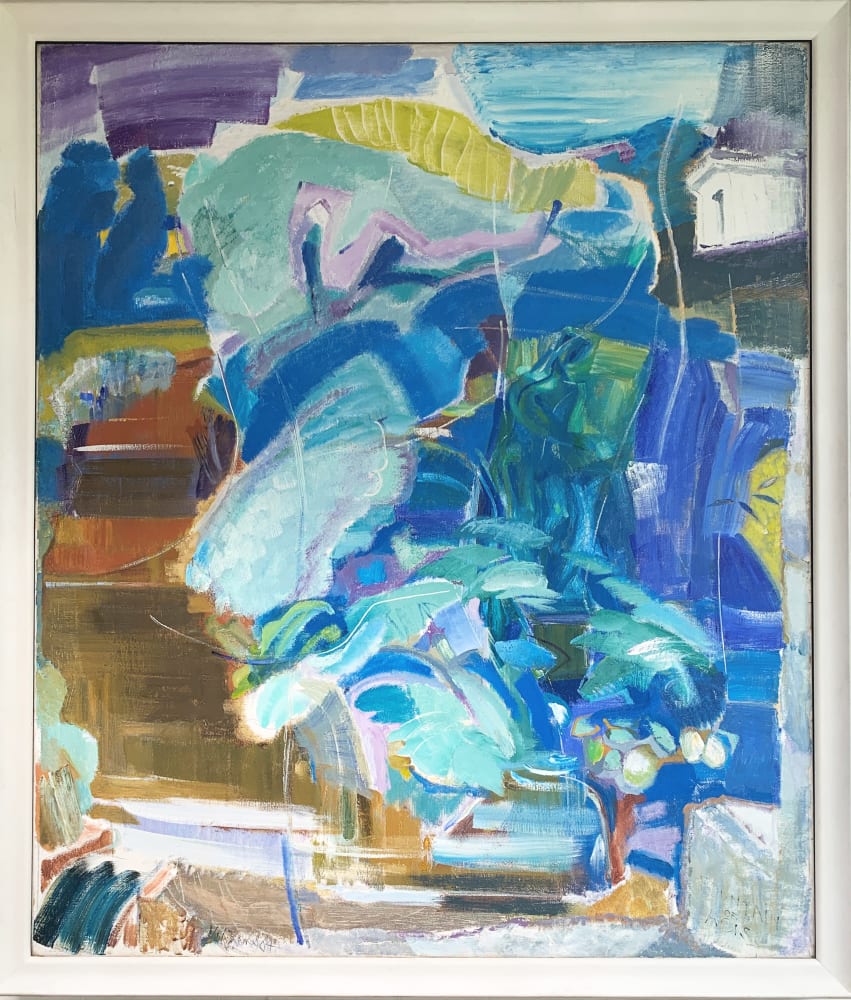
Ivon Hitchens 1893-1979
The Fountain of Acis, 1964
Oil on canvas.
238 x 198.5 cms
93 11/16 x 78 2/16 ins
93 11/16 x 78 2/16 ins
Signed and dated lower left.
Titled lower right.
Titled lower right.
1145
Further images
-
(View a larger image of thumbnail 1
)

-
(View a larger image of thumbnail 2
)

-
(View a larger image of thumbnail 3
)

-
(View a larger image of thumbnail 4
)

-
(View a larger image of thumbnail 5
)

-
(View a larger image of thumbnail 6
)

-
(View a larger image of thumbnail 7
)

-
(View a larger image of thumbnail 8
)

-
(View a larger image of thumbnail 9
)

-
(View a larger image of thumbnail 10
)

-
(View a larger image of thumbnail 11
)

-
(View a larger image of thumbnail 12
)

-
(View a larger image of thumbnail 13
)

-
(View a larger image of thumbnail 14
)

Dimensions including frame: (h) 255cm x (w) 215 cm x (d) 8 cm This huge painting is one of the largest and most ambitious works Hitchens ever painted. The Fountain...
Dimensions including frame: (h) 255cm x (w) 215 cm x (d) 8 cm
This huge painting is one of the largest and most ambitious works Hitchens ever painted. The Fountain of Acis rivals the scale of the latest American painting and reaffirms the artist's status at the forefront of the British avant-garde.
The epic scale, grand proportions and developed iconography make Fountain of Acis an important summation of the artist's ambitions that represents a climax to Hitchens's career. A personal manifesto, Fountain of Acis encapsulates the artist's priorities as a painter and shows him at his most ambitious.
The Fountain of Acis conveys the central importance of both nature and water to Hitchens as well as containing a voluptuous female figure, Greek temple and still life elements. But what it also does is stake Hitchens' claim to be at the forefront of avant-garde developments in Britain, not merely an elder statesman.
The atypical size and format of Fountain of Acis rivals the latest American painting, whilst the freedom in the application of paint serves as a challenge to younger painters such as Lanyon and Heron, who were liberating line and colour from a merely descriptive function, and the motif asserts classical values in the face of the contemporary imagery of a new generation of Pop Artists who had recently graduated from the Royal College of Art.
Painted in the aftermath of two Arts Council exhibitions organised by the Museum of Modern Art, New York, Modern Art in the United States (1956) and The New American Painting (1959), Fountain of Acis suggests that Hitchens had raised his game to produce a painting that asserted his status at the forefront of recent international as well as national trends.
The picture makes a powerful statement about contemporary painting whereby colour and form are freed from a merely descriptive function, yet still retain a basis in nature and in mythology.
Its subject matter, scale and dimensions all created new challenges for Hitchens. These challenges led the artist to surpass his own predominantly small-scale domestic easel painting and to push him to rival the epic ambitions of the latest American abstraction as well as exceed the scale to be found in the recent paintings of Lanyon and Heron. Whilst retaining their roots in perception, in Fountain of Acis Hitchens gave the colours and marks a new resonant autonomy.
Fountain of Acis also illustrates the parallels that Hitchens drew between pastoral music and his own lyrical practice as a painter: the painting's title and subject matter derive from Handel's opera Acis and Galatea, which was one of the artist's favourite pieces of music. In more conventional landscape format easel painting, Hitchens often only chose his title after a picture had been painted and seldom introduced any overt iconography. However, exceptions to this include some of the artist's major commissions such as his mural for the English folk dancing society in Primrose Hill, which prefigures The Fountain of Acis in its emphasis on natural forces alongside the depiction of man.
Inspired by the mythological tale of Acis, a shepherd, and Galatea, a sea nymph, Fountain of Acis focuses on the climactic moment of transformation when Acis, having been slain, is resurrected in the form of a fountain that will flow forever. Hitchens provides an appropriate setting for this tale of immortality by including a classical temple to the upper right of the canvas, a sensuous female figure to the right of centre, presumably Galatea, and the suggestion of the dissolving form of a young male figure, presumably Acis, behind her.
However, what dominates is the tumultuous fountain - the perfect subject for an artist preoccupied with the depiction of water. But now Hitchens gives this leitmotif new meaning. This was perhaps all the more poignant coming as it did from an ageing man. The endless flow of water represents the timelessness of nature. The transformation of Acis serves as a metaphor for never-ending love; and the subsuming of man by nature acts as a reminder of the insignificance and mortality of man.
This huge painting is one of the largest and most ambitious works Hitchens ever painted. The Fountain of Acis rivals the scale of the latest American painting and reaffirms the artist's status at the forefront of the British avant-garde.
The epic scale, grand proportions and developed iconography make Fountain of Acis an important summation of the artist's ambitions that represents a climax to Hitchens's career. A personal manifesto, Fountain of Acis encapsulates the artist's priorities as a painter and shows him at his most ambitious.
The Fountain of Acis conveys the central importance of both nature and water to Hitchens as well as containing a voluptuous female figure, Greek temple and still life elements. But what it also does is stake Hitchens' claim to be at the forefront of avant-garde developments in Britain, not merely an elder statesman.
The atypical size and format of Fountain of Acis rivals the latest American painting, whilst the freedom in the application of paint serves as a challenge to younger painters such as Lanyon and Heron, who were liberating line and colour from a merely descriptive function, and the motif asserts classical values in the face of the contemporary imagery of a new generation of Pop Artists who had recently graduated from the Royal College of Art.
Painted in the aftermath of two Arts Council exhibitions organised by the Museum of Modern Art, New York, Modern Art in the United States (1956) and The New American Painting (1959), Fountain of Acis suggests that Hitchens had raised his game to produce a painting that asserted his status at the forefront of recent international as well as national trends.
The picture makes a powerful statement about contemporary painting whereby colour and form are freed from a merely descriptive function, yet still retain a basis in nature and in mythology.
Its subject matter, scale and dimensions all created new challenges for Hitchens. These challenges led the artist to surpass his own predominantly small-scale domestic easel painting and to push him to rival the epic ambitions of the latest American abstraction as well as exceed the scale to be found in the recent paintings of Lanyon and Heron. Whilst retaining their roots in perception, in Fountain of Acis Hitchens gave the colours and marks a new resonant autonomy.
Fountain of Acis also illustrates the parallels that Hitchens drew between pastoral music and his own lyrical practice as a painter: the painting's title and subject matter derive from Handel's opera Acis and Galatea, which was one of the artist's favourite pieces of music. In more conventional landscape format easel painting, Hitchens often only chose his title after a picture had been painted and seldom introduced any overt iconography. However, exceptions to this include some of the artist's major commissions such as his mural for the English folk dancing society in Primrose Hill, which prefigures The Fountain of Acis in its emphasis on natural forces alongside the depiction of man.
Inspired by the mythological tale of Acis, a shepherd, and Galatea, a sea nymph, Fountain of Acis focuses on the climactic moment of transformation when Acis, having been slain, is resurrected in the form of a fountain that will flow forever. Hitchens provides an appropriate setting for this tale of immortality by including a classical temple to the upper right of the canvas, a sensuous female figure to the right of centre, presumably Galatea, and the suggestion of the dissolving form of a young male figure, presumably Acis, behind her.
However, what dominates is the tumultuous fountain - the perfect subject for an artist preoccupied with the depiction of water. But now Hitchens gives this leitmotif new meaning. This was perhaps all the more poignant coming as it did from an ageing man. The endless flow of water represents the timelessness of nature. The transformation of Acis serves as a metaphor for never-ending love; and the subsuming of man by nature acts as a reminder of the insignificance and mortality of man.
Provenance
The ArtistPrivate Collection, commissioned from the artist in 1963
James Hyman Gallery, London
Acquired from the above in August 2005
Private Collection
Exhibitions
The Flower of Life, James Hyman Gallery, London 2007The Challenge of Post War Painting, London, James Hyman Gallery, 2004












